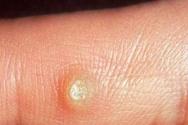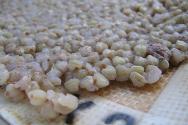How to preserve cheese at home for a long time. Rules for storing soft cheeses. Is it possible to freeze
Blue cheeses, known throughout the world as noble mold cheeses, can be either semi-hard sliced or soft cheeses in their consistency. The most sensitive of cheeses are soft cheeses. It is necessary to constantly monitor the degree of their maturity. Only if the cheese is stored correctly does it retain its quality and excellent taste.
Among the so-called noble mold, internal and superficial mold are distinguished. Internal mold is usually blue in color, grows inside the head of cheese and consists of cultures of the fungus Penicillium roqueforti. This mold is good. Surface mold forms a white fluffy coating on the surface of the cheese. The best examples are Camembert and Brie. Unwanted, bad molds spoil the cheese. Wild white-green or bluish-green mold on fresh, sliced and soft cheese is a reason to sound the alarm. Plaque mold reproduces by tiny spores that are not visible to the naked eye. Therefore, it is impossible to determine by eye how much the cheese is damaged from the inside. With soft cheeses, which include cheeses with noble mold, the growing outer mold at the cut points can be removed completely safely. Blue cheese, which often has an extra shell on top, should be stored in it for as long as possible. When it is opened, the blue mold is again exposed to oxygen, and the mold begins to grow on the surface of the cheese. It's part of the cheese, but many customers believe it's a harmful mold.
All mold cheeses are biologically active. They constantly ripen, acquiring an ever stronger taste. This is a natural process that intensifies as the temperature rises. Cheeses cannot be stored at temperatures below 0°C. If cheese freezes, then when it thaws the cheese crumbles and acquires a grainy consistency. To prevent excessive sharpness and softening, noble mold cheese should be stored at a temperature of +1+6º C. In the refrigerator, it is better to keep it in the vegetable compartment, where the temperature is most suitable (for cheese this will be a kind of cellar). Relative humidity should be around 90-98%
Cheeses with noble mold should always be packaged separately, as noble mold easily spreads to other types of cheese. The cutting surface of the cheese should always be covered. It is better to store cheese in the packaging in which you bought it, and wrap it in it after each use. You can also use cling film or foil. Also, in order to preserve the special aroma characteristic of these cheeses, they are wrapped in parchment.
For cheeses with noble mold, you should have a separate knife - with a short blade. In this case, the back of the knife should be very thin or perforated so that the cheese mass does not stick to the blade. This knife should only be used to cut soft, gourmet cheeses to prevent blue mold cultures from spreading to other varieties. 
Despite the fact that blue cheeses are very healthy (contain up to 25 percent of highly digestible protein, vitamins and minerals), consumption of such cheeses is contraindicated for children and pregnant women due to the risk of listeriosis. Blue cheeses can also cause allergies. If the shelf life is violated, blue cheese becomes harmful to everyone: improperly stored mold bacteria turn into pathogenic bacteria. Unfortunately, there is no information available anywhere about the shelf life of specific brands of cheeses with noble mold. That's why, best advice there will be a desire not to buy too much of this cheese at once, and not to delay the use of what has already been purchased.
If stored incorrectly, cheese spoils quickly. Each type of this product has its own characteristics, so the storage method will be different.
Storage conditions and duration depend on the specific type of cheese. Depending on the method of preparation, there are several varieties of this wonderful product:
- The most common hard cheese for the average consumer. It is dense in structure, with small holes.
- Semi-solid. It's a little softer, but still springy, and the holes look like holes in it.
- Soft cheeses that are convenient to spread on bread.
- Brine. They are necessarily surrounded by the liquid in which they matured.
- Fused - elastic and viscous.
- Delicacy cheeses with harmless mold (for example, Dor Blue).
- Homemade cheese, made from natural products, including sheep and goat.

Rice. 1 - Storing homemade cheese
Shelf life table
Refrigerated storage conditions
The best place for cheese is the bottom shelf of the refrigerator, where the temperature is optimal. There are two most important indicators for maintaining the freshness of any cheese: temperature and humidity.
Regardless of the variety, the optimal storage conditions for such a delicate product are a temperature of 3-8 degrees and a humidity of 90%.
Higher temperatures promote the growth of bacteria, accelerating the appearance of mold and increasing the risk of poisoning. Low temperature destroys the structure, and low humidity provokes dehydration and “drying out”.

Rice. 2 - Cheese in the refrigerator
Hard and semi-hard cheese
Hard ones include, for example, Parmesan, Hollandaise and Tilsiter. These varieties are the most unpretentious and are stored longer than others, but usually no more than 10 days. It is important to comply with the following conditions:
- You cannot wrap cheese in plastic wrap, including food wrap! It prevents it from “breathing,” significantly worsening its smell and taste. After purchasing, you need to wrap the product in parchment paper. As a last resort, you can place it in a plastic bag, but you should make sure that there is enough air in it. You can put a small lump of sugar directly into the bag of cheese, this will slow down the formation of mold.
- You cannot move cheese from shelf to shelf - temperature changes will negatively affect its quality.
- It is necessary to check the piece regularly. If, despite all your efforts, it becomes moldy, you can cut off the moldy part, wrap the remaining cheese in a new layer of parchment and use it for food.
- An hour before consumption, you need to remove the cheese from the refrigerator and open access to air. This technique will allow the product to return its original taste and smell.
- Cheese easily ventilates, which is why you shouldn’t store the slices. Or even just leave chopped or grated cheese for a long time.
Hard cheese, unlike other varieties, can be stored in the freezer. But only if you use it as an ingredient for cooking various dishes. It will not be possible to make slices from defrosted cheese - it will crumble a lot.

Rice. 3 – Freezing cheese for making pizza
Other types
How long a particular type can be stored is usually indicated on the packaging, but as a rule, soft varieties are stored for no more than three days, while smoked ones last a little longer. Under no circumstances should such a product be left open - this will lead to the formation of a dry crust and the appearance of an unpleasant odor. It is best to use the original packaging; if this is not possible, put it in a glass or enamel container and cover it as tightly as possible with a lid.
Proper storage of brine cheese involves keeping it in liquid. The brine in which it was purchased will be optimal. If for some reason this option is not possible, you need to prepare the brine yourself using water or whey. To prepare, you can use the following recipe: dissolve 200 grams of salt in 1 liter of cold boiled water. Before serving, you can reduce the salty taste by soaking in warm boiled water or milk for an hour. It is permissible to store brine cheeses out of liquid, but not more than 5 days, in enamel containers and under a lid. By the way, some of the varieties, for example, feta cheese, can be stored in the freezer. This will change the taste somewhat, but the product will be suitable for eating.
Processed cheese can be stored for no more than two days. Film and plastic bags are not suitable for packaging an open piece. It is better to transfer it to a glass container and close it tightly. You can use an airtight container.
Storing blue cheese has its own characteristics. This group has a shell made of specially grown harmless mold, which, despite its beneficial features, can spread throughout the refrigerator. Without following the rules, a specific aroma will permeate the surrounding products. Like hard cheeses, moldy cheeses should be packed in parchment paper and then placed in an airtight container.

Rice. 4 – Storing blue cheese in parchment
Cheese prepared at home (Adyghe, Suluguni) is stored for a shorter period of time than a factory-produced product. It is optimal to use it within three days. Store in enamel or glass containers in an airtight container. But homemade cheese, just like durum varieties, can be frozen. When frozen, it can last for several months, retaining its taste and smell when defrosted. Regardless of the type of cheese, when packaging it, you should definitely make a note about the date of its manufacture and expiration date. This will help prevent you from eating expired food.
There are force majeure circumstances when it is not possible to use the refrigerator. A cotton cloth soaked in a saline solution will help preserve the freshness of the cheese - you need to wrap the piece with it, then place it in a place inaccessible to direct sunlight. In this state, hard cheese can be left for up to 7 days.
In order to get maximum pleasure from this delicious and useful product, you should use the following tips:
- If hard cheese has dried out, you can refresh it. To do this, you just need to put it in cold milk for several hours - the softness will return.
- It is better to store any cheese as a whole piece, rather than in parts.
- Under no circumstances should you try to replace parchment paper for packaging with regular paper - this will only speed up dehydration and spoilage of the product. You can store cheese in foil.
You can preserve the freshness, taste and aroma of almost any cheese! But if, despite the fact that the cheese was stored correctly, even the slightest suspicion arises about its freshness. It’s better to throw it away immediately: is it worth risking your health?
A tasty, healthy dairy product called cheese is loved by adults and children. Today, cheese products made from milk are available for sale in a wide variety. Buyers in retail chains can choose from processed and homemade cheeses, blue cheeses, hard cheeses, Russian and many other types. But how to save valuable product at home so that it stays fresh for a long time?
About the rules of conservation
Cheese is a live fermented milk product due to the content of the bacterial component and beneficial microorganisms. To preserve the usefulness of the product, you need to know and follow the principles of storage. If stored incorrectly, the short shelf life will decrease and the product will become unfit for consumption.
Cheese in the refrigerator
To prevent this from happening, pay attention to the following nuances:
- The optimal temperature regime should be within +3+8 0 C.
- Humidity should be at least 90%.
- The product should be stored in a container, without leaving the slices uncovered.
If you place dairy products in a low-temperature chamber, all the beneficial components will die and the special taste will be lost. When placed in a high-temperature chamber, pathogenic microbes are activated in the cheese, which will lead to unsuitability. Humidity must also be appropriate. If the level is insufficient, the cheese will dry out. And if it is elevated, it will deteriorate.
About storing different varieties
You can store hard cheese in the refrigerator without losing its taste by regularly checking whether the product has weathered or mold has formed. Durum varieties can be stored for up to 12 days from the date of production.

Soft cheeses, such as feta cheese and similar ones, can be stored for no more than a week at a temperature of +3+10 0 C. If you place the product in a chamber operating at a temperature from 0 to -2, it can be stored for 25-30 days. After opening the container processed cheese, it can be stored for no more than two days.
It is better to store varieties of blue cheeses without loss of taste in tight containers at positive temperatures. This will ensure the safety of the product and protect other dishes in the refrigerator from the strong smell of cheese.
It is advisable to store brined cheeses in salt water. And so that the product does not seem too salty, before serving, it is cut into portions and kept in milk. It is better not to wash these types of cheeses in warm water, as the product will lose its taste and aroma.
Dairy homemade require special treatment. Since this is a natural product, it should be stored for no more than five days in glass or enamel-coated containers. If there is a lot of product, it can be distributed into portions and placed in the freezer. Thus, keeping the products fresh for a long time in the refrigerator will be easy and simple.

Parmesan can be preserved without loss of taste in its original container, in small portions. If the Parmesan is chopped or grated, you can keep it that way by wrapping it in parchment paper. It is recommended to store on the top shelf of the refrigerator.
Where and in what container should I store it?
The refrigerator is the best option for storing cheeses. However, in this case, the time and conditions of preservation must be observed. The ideal place for proper storage of cheeses is a shelf for perishable products. It is here that the conditions are most suitable for long-term storage of dairy products. To prevent the cheese from chapping, it should be placed in a special container. You can replace containers with a bag or film.

Do not wrap cheese in paper wrapper. It will dry out the product. It is better to replace paper with parchment and a bag. If there is no suitable packaging other than the bag, you should put one or two pasta in plastic at the same time as the cheese. This will protect the cheese from excess moisture.
Of course, the most successful option is to store cheese products in a large head. However, such a purchase is not available to everyone today. A small portion of cheese taken with you on the road can be easily preserved if you wrap it in a cloth napkin previously soaked in water. Of course, you need to keep such a product in the shade, away from the heat.
About the duration of storage in the freezer compartment
Professional chefs do not recommend storing cheeses in the freezer. After all, low temperatures cause cheese to lose its taste and consistency. There are situations in which cheese has to be frozen. Of course, after defrosting, the product should not be used for sandwiches, but as a filling for pizza, pie or salad, it is quite suitable. The only type of cheese that is absolutely not afraid of freezing is Parmesan. If you store it at a temperature from -15 to -20 0 C, then the taste will not be lost for three months.
In custody
In order for the cheese to remain tasty and fresh for a long time, it is important to follow the tips for storing it. Of course, this product should be stored in a refrigeration device in a bag or vacuum packaging. A good option is to store cheeses in containers made of ceramic, glass or plastic. But in order not to think about how and where to store cheese products, it is better to buy them in small portions, without storing them for future use.
Among the variety of dairy products, cheese occupies a special place. Its role in cooking is enormous - it is an ingredient in many dishes: casseroles, appetizers, salads, soups and others. But it still often happens that you have to throw away a piece that is lying around, which has already become moldy.
Often it is ignorance of storage rules that leads to the fact that the product begins to dry out, loses its attractive appearance, taste and aroma, and ultimately becomes simply unusable. Since cheese is a living product that is constantly developing, ignorance of storage rules can cause an acceleration of its ripening process.
As you know, everyone has different tastes, and this also applies to cheeses. But lovers of this or that type of cheese are united by the same question: how long to preserve the cheese so that it does not spoil.
How long can you keep cheese without mold?
It's no secret that cheese is made from milk, and not always cow's milk. Goat's and even sheep's milk can be used. This fact, as well as the manufacturing methods, determines the following types of cheese:
Hard – cheeses with a dense structure. Their lifespan under pressure is about 6 months. There are no large holes in hard cheeses; usually they are small and unnoticeable. These are Parmesan and Edam cheeses;
Semi-hard – cheeses that combine soft consistency and dense structure. They can have holes of various sizes. An example of cheese is “Maasdam”;
Soft – cheeses that do not require additional processing during manufacture. They do not have a covering shell and a characteristic taste for the entire variety. Each soft cheese can be easily distinguished by its aftertaste, for example, mushroom or creamy. The most striking representative of this species is “Mascarpone”;
Brine cheeses are cheeses that can fully ripen only if there is a brine solution. A well-known example is Suluguni cheese;
Processed cheeses that contain, in addition to butter and cottage cheese, condensed milk, cream or other products. To ensure the cheese is fully cooked, melting salts are added before finishing the processing;
Cheeses with mold - for their creation there is a special technology that allows the production of food-grade edible mold. This mold is absolutely harmless to the human body, it can be of various colors: blue, green, red.
Each type of cheese can have, in addition to a different consistency and taste, a different shelf life. It is necessary to carefully approach the question of how to preserve cheese, so as not to inadvertently eat a missing or moldy product. Naturally, any cheese should be stored in a damp, cool place, that is, in the refrigerator. Cling film or parchment in which the product must be stored will ideally protect the cheese from drying out and spoilage.
The best storage temperature for hard and soft cheeses is 10°C, so place under freezer doesn't suit them. It is better to place such cheeses away from the icy cold, for example, on a shelf in the refrigerator door.
How to preserve cheese: rules for storing hard and soft varieties
Compared to other types of cheeses, hard cheeses retain both their good appearance and taste much longer when stored in the refrigerator. However, its shelf life is also limited to 10 days, so you should not make large stocks of such a product in advance. You need to regularly check its crust for mold spots. Best conditions, in which hard cheese will last the maximum number of days are:
Well ventilated place;
Air temperature from 3 to 10 °C;
Air humidity 90%.
To avoid the premature appearance of mold, you can put an ordinary cube of refined sugar in the packaging of the cheese. It is better to store hard cheese in plastic wrap or parchment, but not ordinary paper, in which it will simply become covered with a dry crust.
Cheese and constant shifting from shelf to shelf do not have the best effect on the condition of such cheese; it is all due to the difference in temperature conditions.
Before slicing the cheese and serving it, you need to prepare it 1 hour in advance, first removing the dairy product from the refrigerator. This way it will be able to remove all the unpleasant odors it previously absorbed from the refrigerator. In the case of leftover sliced cheese, the best thing to do is simply try to eat it. Because in the refrigerator the inevitable fate of being covered with a dry crust awaits it and a further trip to the trash can.
Soft varieties of cheese are not afraid of even sub-zero temperatures, but in such conditions their shelf life is significantly reduced to 3 days. The packaging contributes to the shelf life; it also protects the cheese from chapping and the formation of a dry crust. The ideal way to store soft cheese is to place it in enamel pan small in size, but sealed packaging from the factory is also suitable.
If there are several types of cheeses, they must be stored separately. This is very important, since each cheese has its own unique taste, aroma and ingredients. Mixing varieties can spoil even the freshest produce.
Sometimes certain types of cheese make rare appearances in people's refrigerators, such as for holidays or special occasions. It is impossible to determine by eye the optimal conditions for long-term storage. In this case, manufacturers will come to the rescue, indicating on the packaging both the appropriate temperature and shelf life of the product.
How to keep cheese in the refrigerator longer: other varieties
At home, you should try to store cheese that is intentionally produced with mold in commercially available sealed packaging. The more it covers such cheese, the better for the rest of the products. This way, mold, even though it is food-grade, will not be able to spread to other products and cause not the best emotions. Properly storing blue cheese should be either in a glass or plastic container with a tight-fitting lid, or in cling film that does not allow air to pass through.
Brine cheeses got this name because of the way they were stored. The dairy product should be kept in a weak solution of table salt. The cheese will be stored longer if you place it in a glass jar or enamel pan.
Processed or homemade cheese is best stored on the bottom shelf of the refrigerator, like many other types. Storage in a plastic bag should be avoided unless glassware will make the shelf life as long as possible. Homemade cheese, which was prepared with one’s own hands, has a shorter shelf life than a factory-made product. Therefore, you need to eat it as quickly as possible, within 2-3 days.
How long to preserve cheese: timing control
The maximum period that can be allotted for storing a particular type of cheese always depends on storage conditions, temperature in particular. If the air temperature drops by 3 °C, dairy products may spoil. This does not apply only to homemade cottage cheese, which is not afraid of even freezing, and soft cheeses that are designed for quick use. With frequent changes in temperature and humidity levels, there is a high probability of spoilage dairy product. To maximize the shelf life, you need to carefully monitor these indicators and the availability of packaging for the cheese. It should not lie on the refrigerator shelf without packaging.
If the household does not have enamel containers for storing cheese, you can use an ordinary glass jar with a lid as a vacuum container.
If all necessary conditions are maintained, hard cheeses can be stored for 10 days in the refrigerator, while all others, that is, soft, processed, pickled, and moldy, have a shelf life of no more than 3 days. There are some exceptions in the form of, for example, Brie, Camembert, Roquefort cheeses, which can last in the refrigerator for 7 days if they are allowed to breathe every 2-3 days.
Useful tips on how to keep cheese longer in the refrigerator
Cheese can be stored in the refrigerator for as long as possible if:
Provide it with sealed packaging or vacuum container;
Keep the brine variety in a jar with milk or saline solution;
Place the sugar cube in the pan or package where the cheese is, and periodically replace it with a new one. This will remove excess moisture;
Store it in one piece, bought in a store, and do not cut it into many small pieces, as they will weather faster and their edges will become dry;
Do not use paper for storage, but replace it with foil or a special cheese pan for large volumes of cheese;
Do not contribute to constant temperature changes and store cheese on the side shelf of the door or the bottom shelf of the refrigerator;
Store each type of cheese separately from each other;
Place the cottage cheese in a glass or plastic container, close the lid tightly and place in the freezer.
If for some reason it is impossible to use a refrigerator to store cheese, then you can extend this period without it. You just need to wrap the piece in a cloth soaked in salt water and hide it away from the sun. Hard cheeses will retain their properties for 7 days, the rest will last 2 days without compromising quality.
In fact, you don’t need to be a cheese expert or know a lot of tricks to maintain the freshness of a dairy product for a long time. The main rule is not to eat cheese whose expiration date indicated on the package has long passed.
Cheese is a favorite product for many
Indeed, there are plenty of parmesan and mozzarella lovers in our country. Currently, it is simply amazing in its diversity, and each person has the opportunity to choose a “cow” product that is suitable in terms of quality and price. It is an integral ingredient in pizza, some types of cold and hot soups, and salads. Of course, it is very important that it is fresh in the prepared dishes, so the question of how to keep cheese in the refrigerator longer is of interest to many. It is also worth noting that the above product is rich in proteins, vitamins and amino acids, which makes it extremely valuable for health.
If you do not comply with the conditions for proper storage of the “cow” product, it will dry out quickly, its appearance and taste will deteriorate. However, the question can be solved, not just one, but several. Let's look at it in more detail.
Packaging must be correct
Those who want to know how to preserve cheese in the refrigerator for a longer time should remember that in order to preserve the “natural” taste, each piece of the product must have individual packaging. However, you should not use plastic bags in which the cheese simply “stops breathing.” Naturally, this leads to a deterioration in the taste of the product. In addition, there is a risk of bacteria, which is also not a favorable factor.
When considering the question of how to store cheese in the refrigerator, it should be emphasized that hard varieties of the product do not spoil for as long as possible. having a pronounced aroma, it is recommended to wrap it in cling film before placing it in the refrigerator. which does not have such a specific odor, is best placed in an enamel or glass container. You cannot wrap the “cow product” in paper, as it will quickly begin to stale and deteriorate. As an alternative, we can recommend parchment.
Store only in a cool place
If your home does not have a basement or cellar, then the only option to preserve the quality of the above food product is the refrigerator.

Moreover, it is very important to maintain the correct temperature (6 to 8 degrees Celsius) and humidity (90%). This is certainly one of the main secrets of how to store cheese in the refrigerator.
Avoid temperature changes
The “cow” product does not like temperature changes. All this risks the fact that it will begin to crumble, deteriorate and change its natural taste. To minimize these risks, always place cheese on the bottom shelf of the refrigerator.
Storage must be separate
It should be noted that Parmesan or mozzarella absorb the odors of their environment, therefore, as already emphasized above, it is not recommended to store cheeses different types in one package. In addition, each of them has its own unique aroma, and it would be a mistake to keep them in the same dish or container.

You should also remember to wrap them in cling film after eating, since cheeses not only absorb the aroma, but also distribute it.
Don't cut off the crust
Storing cheese in the refrigerator will be correct if you do not remove the rind from the product. It allows you to preserve the aroma of the cheese. It is very important to remember another important secret - you do not need to pre-cut the cheese, as this will cause it to dry out. It is necessary to cut off exactly the amount of product that you intend to eat.
Don't stock up
We should not forget the rule that no cheese can be stored for too long, especially if we are talking about a product that was made on the basis raw milk. When going to the grocery store, you shouldn’t buy kilos of cheese - it would be advisable to buy a small amount of Roquefort or Eden. In this way, you will not allow the product to “stay” in your home. Agree, it is better to visit the supermarket one more time in order to subsequently enjoy the aromatic taste of fresh cheese.
Features of storing homemade cheese
Cheese made with your own hands should not be stored in the refrigerator for too long: it is best to eat it within 3-4 days.

We remind you once again: do not try to put it in a plastic bag - store it in a glass or enamel container.
Features of storing pickled cheeses
Types of cheeses such as feta cheese, suluguni and feta are optimally placed in brine or special whey in order to preserve the quality of these products. To remove salt, such cheese is first cut and then soaked in milk for about 8-9 hours.
In particular, feta cheese does not spoil for a very long time after soaking, while suluguni does not have this quality. However, there is still a solution to this problem: “Georgian” cheese should be stored in an airtight container filled with brine. In this case, it will be fresh for three months.
Shelf life
For many, the question of how long cheese can be stored in the refrigerator is of paramount importance. The answer to this depends on what varieties of “cow” product we are talking about. In particular, hard ones may not spoil for about 7-10 days. Soft varieties remain fresh for 3 days as they age quite quickly.

As for processed cheese, it remains fresh for only 2 days, after which all flavors and useful qualities such a product. Now you know how long cheese can be stored in the refrigerator.
If for one reason or another the “cow” product nevertheless becomes dry, then the situation can be corrected by soaking it in milk. If mold has formed on the cheese, you should cut it off, but you do not need to throw away the cheese itself: add it as an ingredient to the dish you are preparing. Vacuum packaging will help extend the “shelf life” of any cheese.







